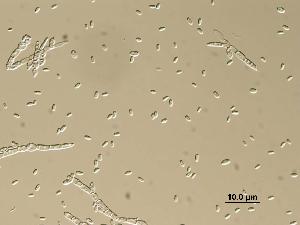
Coniochaeta ligniaria, an Ascomycete isolated from soil and decaying plant material, is relevant to bioenergy because it has unique metabolic capabilities and inhibitor tolerance. The presence of inhibitors is a major obstacle impeding use of lignocellulosic biomass to produce fuels and chemicals. Inhibitory compounds are generated when biomass is deconstructed (pretreated) to liberate sugars. Biomass sugar streams thus typically contain microbial inhibitors, such as furan and aromatic compounds, which interfere with conversion of sugars to products. C. ligniaria NRRL30616 was isolated in a screen for microbes that are tolerant to the harsh milieu of hydrolysed biomass. C. ligniaria NRRL30616 both withstands and mineralizes a number of the inhibitory compounds. This metabolic capacity may be harnessed to detoxify biomass sugars in a process termed bioabatement, in which inhibitory compounds are removed by metabolism. Bioabatement using C. ligniaria NRRL30616 has been shown to generate a cleaner, fermentable sugar stream from hydrolyzed biomass. The genome sequence of C. ligniaria NRRL30616 and related fungi will provide information about metabolism of inhibitory compounds, degradation of lignocellulosic biomass, and tolerance to environmental stress.
Genome Reference(s)
Jiménez DJ, Hector RE, Riley R, Lipzen A, Kuo RC, Amirebrahimi M, Barry KW, Grigoriev IV, van Elsas JD, Nichols NN
Draft Genome Sequence of Coniochaeta ligniaria NRRL 30616, a Lignocellulolytic Fungus for Bioabatement of Inhibitors in Plant Biomass Hydrolysates.
Genome Announc. 2017 Jan 26;5(4):. doi: 10.1128/genomeA.01476-16
